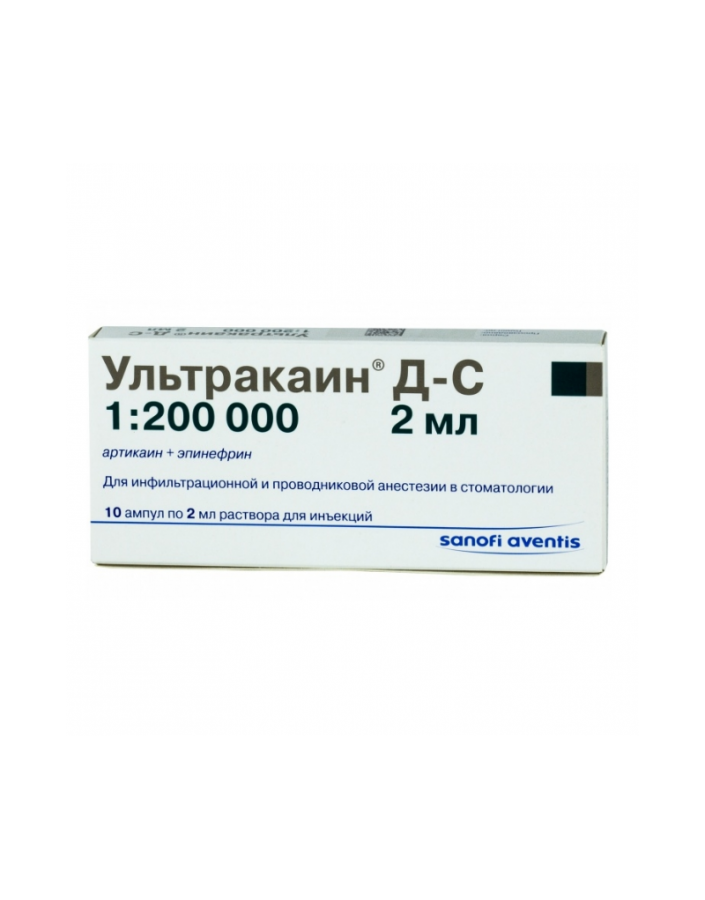




Security policy (edit with Customer reassurance module)

Delivery policy (edit with Customer reassurance module)

Return policy (edit with Customer reassurance module)
Ultracain® D-S.
INN or grouping name: artikain + epinephrine and.
Dosage form: injection.
In 1 ml of solution contains:
active ingredients: articaine hydrochloride - 40 mg and epinephrine hydrochloride - 0.006 mg (equivalent to the base content of epinephrine - 0.005 mg, which corresponds to the content of epinephrine in a solution of 1: 200,000);
excipients: sodium disulfite (sodium metabisulfite), sodium chloride, water for injection.
Transparent colorless liquid.
local anesthetic agent + alpha and beta adrenomimetic.
Pharmacodynamics
The drug Ultracain® D-S, used for local infiltration and conduction anesthesia in dentistry, is a combination drug that contains articaine (amide-type local anesthetic) and epinephrine (adrenaline) (a vasoconstrictor). Epinephrine is added to the formulation to prolong the action of anesthesia. Artikain has a local anesthetic effect due to the blockade of potential-dependent sodium channels in the cell membrane of neurons, which leads to a reversible inhibition of the conduction of impulses along the nerve fiber and a reversible loss of sensitivity.
The drug Ultracain® D-S has a fast (latency period from 1 to 3 min) and a strong anesthetic effect and has good tissue tolerance. The duration of anesthesia is at least 45 minutes.
Children
In a clinical trial involving 210 children aged from 3.5 to 16 years, the use of Ultracain® D-C at a dose of 5 mg / kg body weight provided a sufficient local anesthetic effect during mandibular infiltration or maxillary conductive anesthesia. The duration of anesthesia was comparable in all age groups and depended on the amount of the drug administered.
Pharmacokinetics
Artikain is rapidly and practically immediately after administration, it is metabolized (by hydrolysis) by nonspecific plasma esterases in tissues and blood (90%); the remaining 10% of the dose of articaine is metabolized by microsomal liver enzymes. The main metabolite of articaine, articaine, which is formed in this case, articaic acid, does not possess local anesthetic activity and systemic toxicity, which allows for repeated administrations of the drug. The concentration of articaine in the blood in the area of the alveoli of the tooth after submucosal administration is hundreds of times higher than the concentration of articaine in the systemic circulation. The binding of articaine to plasma proteins is approximately 95%. Artikain is excreted through the kidneys, mainly in the form of articaic acid. After submucosal administration, the half-life is approximately 25 minutes.Artikain penetrates the placental barrier, practically does not stand out with breast milk.
Indicated for local anesthesia (infiltration and conduction anesthesia) in dentistry. Planned interventions, such as uncomplicated removal of one or more teeth, treatment of carious cavities and teeth grinding before prosthetics.
- Hypersensitivity to articaine or to other local anesthetic agents of the amide type, except for cases when allergy to articuin was excluded with hypersensitivity to the local anesthetic agents of the amide type using appropriate studies conducted in compliance with all necessary rules and requirements.
- Hypersensitivity to epinephrine.
- Hypersensitivity to sulfites (in particular, in patients with bronchial asthma and hypersensitivity to sulfites, as it is possible to develop acute allergic reactions, such as bronchospasm) and any other auxiliary components of the drug.
- In patients with chronic heart failure, coronary heart disease, angina pectoris, atherosclerosis, myocardial infarction in history, heart rhythm disturbances, arterial hypertension.
- In patients with cerebrovascular disorders, history of stroke.
- In patients with chronic bronchitis, emphysema.
- In patients with diabetes mellitus (potential risk of changes in glucose concentration in the blood).
- In patients with cholinesterase deficiency (use is possible only if absolutely necessary, since prolongation and a pronounced increase in the action of the drug are possible).
- In patients with bleeding disorders.
- In patients with severe impaired liver and kidney function.
- In patients with marked arousal.
- In patients with epilepsy in history.
- When combined with halogen-containing agents during inhalation anesthesia
The drug is intended for use in the oral cavity and can be administered only in tissues where there is no inflammation.
Impact on ability to drive vehicles and engage in other potentially hazardous activities
The decision about when the patient after dental surgery can return to driving and other potentially hazardous activities that require increased concentration and psychomotor speed must be taken by a doctor.
Ampoules: at a temperature not exceeding 25 ° C in a dark place.
Cartridges: at a temperature not exceeding 30 ° C in a dark place.
Keep the drug out of the reach of children.
List B.